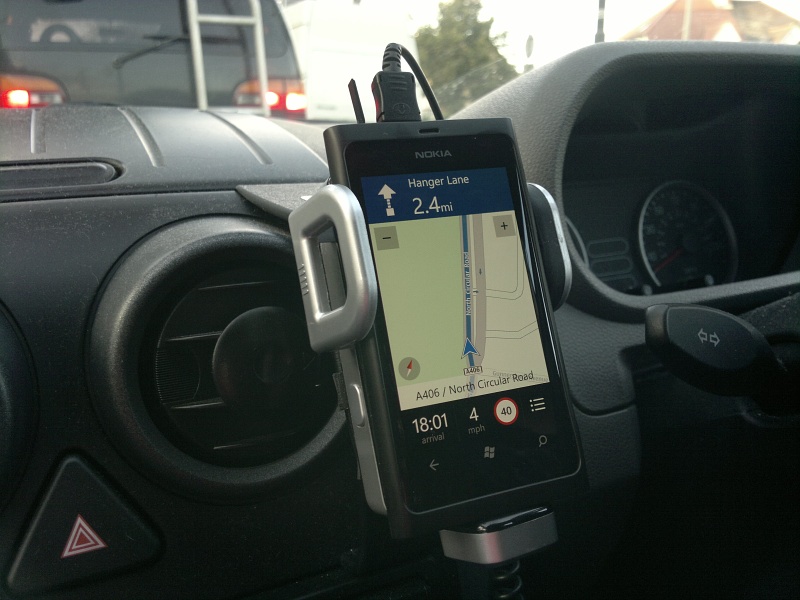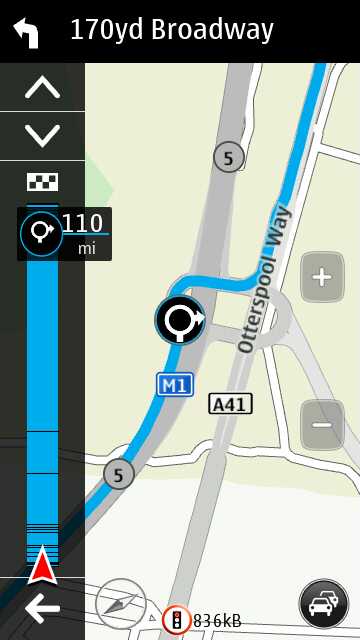
Mark Johnson writes:
For me, satellite navigation is one of the must-have features on a smartphone. Indeed, it’s what got me into ownership, with a Nokia 3230, a GPS mouse, Tom-Tom and a program to allow the phone to connect to both a Bluetooth GPS receiver and a Jabra BT headset simultaneously. Four upgrades later, my N8 performs sterling service as my sat-nav, camera, personal stereo and occasional telephone. As I write programs for fun, I also have a Lumia 800. I got this on a great deal, hoping to use it as a development phone.
As well as my daily commute of about 10 miles each way from my home in Derby, I have a regular trip to see my girlfriend, who lives in north-west London, a trip of about 125 miles. I’m going to use this latter trip to compare Nokia Drive on both phones.
Preparation
As the well-known phrase goes, proper planning prevents poor performance. Both versions (Symbian and Windows Phone) of Nokia Drive assist here, allowing side-loading of map data in advance. This means that you can use both versions to navigate without using data if you needed to. The N8 version, however, allows you to check for updates manually.
I normally launch the N8 version of Nokia Drive from within the useful Car Mode application. Until recently, this launched automatically upon connection to my car stereo which has Bluetooth built in. The latest version seems to have broken this. There’s no equivalent for Windows Phone, but the 'Metro' interface (which is growing on me - it’s fresh, clear and easy to read) has large, clear buttons, not that you should really be touching the phone whilst in motion. I have a Nokia CR-99 holder securely attached to a Brodit mounting bracket, so the phone is safely within reach and in view. I’ve had to remove the rubber grip off one side of the holder to fit my N8 in its Otterbox case, but it’s still secure.

Upon launch, the N8 version is immediately more friendly, opening with three buttons: Set destination, Drive home and Just drive, as well as a check to enable live traffic rerouting. The Lumia version doesn’t have traffic; only a My Commute feature which, as far as I can make out, offers traffic information for a set journey. As it’s unavailable in the UK as yet, it’s a moot point.
As you might expect, both versions allow searching for addresses, including by UK postcode. This can be done online or offline, but the offline index is more limited. The Lumia version scores here, simply because the virtual keyboard is better, even without Swype. The N8 version also now allows searching by voice. This seems to work well in the house, although being soft-spoken, I have to speak a little louder than normal. Impressively, it appears to understand postcodes, both reading out the letters ('aitch ay nine', etc....) and using NATO phonetic codes ('hotel alfa nine'...) It doesn’t work at all when connected to my car stereo, however, and is not available when running Drive through Car Mode.
Both versions allow you to save favourite addresses, but only the N8 version shares those with Nokia Maps, both on the phone and on the Maps website, via a Nokia account. Similarly, only the N8 version allows you to search the Maps POI database from within Drive. This clearly shows the differing development of the two versions - the N8 Drive is an offshoot of the original Maps application, whereas the Lumia version of Drive is a totally separate app from the Lumia Nokia Maps app. You can use Lumia Maps to search for POIs and get directions, but not live navigation. This is very strange and rather disappointing, although a moot point as the test address is firmly lodged in the favourites. You can also store routes in your Nokia account, which is useful as it allows you to plan and store routes and waypoints on a nice, big laptop screen. The N8 also allows you to navigate to Contacts, although this requires you to first find them in maps, which alters the address format.
My initial comparison of the routing speed of the two versions appeared to indicate to me that the Lumia version is quicker. Indeed, I first thought that it was caching routes, so when I actually timed the routing rather inexpertly with my watch stopwatch, I used random postcodes off the back of a Haynes manual and a Coke can(!) In both cases, the Lumia was about twice as fast as the N8, even with the N8’s live traffic rerouting switched off. I hasten to add that not only are my times dependent upon my lack of coordination, but on the programs - the Lumia stops on an overview screen, where you can review the route before starting navigation, whereas the N8 launches straight into the navigation. The N8 does have a route overview, but this is on the menu, of which more below. The longest wait was around 11 seconds for the N8, with live traffic rerouting turned on.
Speaking of routing, the Lumia version has no way of adjusting the route based on your own preferences, unlike the N8, where you can choose a faster, shorter or ‘optimised’ route, and avoid traffic, motorways, toll roads and the like. As mentioned above, my girlfriend lives in Wembley. Using the ‘optimised’ setting, and with 'avoid traffic' turned off (the other options being irrelevant), the N8 came up with a route which took me down the M1, turning off onto the A41 at Watford and then along Elstree road and through Harrow Weald - a distance of 120 miles and estimated duration of 2h16. The Lumia came up with a route straight down the M1, along the North Circular and through Wembley town centre - 126 miles and again 2h16. This is pretty much the route that the N8 comes up with on the faster setting, whereas the shorter setting is similar to the optimised route, apart from wanting to take me down a no-vehicles-allowed street close to my house. Interestingly, the optimised route is similar to the one my father used to take to Wembley Stadium when he worked as a coach driver.


On the road
When I tested the routing speed, I noticed that, while the N8 started giving instructions straight away through the loudspeaker, the Lumia was silent. The N8 uses the loudspeaker most of the time, outputting via Bluetooth only while already connected such as when playing music. Lumia doesn’t use the speaker at all, only outputting via Bluetooth. As I’m using my car stereo as the Bluetooth audio device, this can cause the first few words of the instruction to go missing if I’m not listening to music from my phone. Both phones handle playing music while running Drive fine, allowing the instruction to play over the music. I did notice that switching away from Drive on the Lumia causes it to have to regain the GPS signal when switching back. This is an artefact of Windows Phone’s limited multitasking. Given that it’s a bad idea to be fiddling with your phone whilst driving, this might not be such an issue, but handling calls whilst navigating is something I didn’t test.
Both phones give clear instructions, although only the N8 has the option of saying street names and road sign information. It does this by text-to-speech, which can cause amusing effects - it says Loughborough two different ways, neither of which is correct (it should be 'Luff-burra', in case you’re interested). The N8 also has lane-assist, showing which lane you should be in at major junctions.
Both phones have a similar navigation interface: a large 2D or 3D map with a strip above for directions, and an area below divided between the ETA, live speed with speed limit and the menu button. I must say that the Lumia, with its larger screen and the clear, sharp Segoe typography, looks the better of the two. The N8 also gives safety camera warnings, which the Lumia lacks, although both phones do have speed limits clearly displayed, along with audible warnings if you should happen to stray above the limit, apparently. Finally, the N8 shows traffic conditions as green, yellow or Red stripes along major roads. This, of course, depends on the accuracy of local traffic data.
You have reached your destination
From my testing, Lumia Drive is perfectly usable, and I would say it’s about where the Symbian version of Nokia Maps was on my old X6 a couple of years ago. And that’s the problem. There are a lot of N8 owners who are coming to the end of their contracts and will be looking at what’s available on Windows Phone and elsewhere, because there are no Symbian phones available from the networks or the major high-street stores, at least here in the UK. At the moment, unfortunately, Drive on the Lumia is lacking important features like live traffic, speed cameras, lane assist, street names and integration with Maps (both on the phone and website), all of which make Nokia Maps/Drive on Symbian such a killer application, on a par with both standalone units and paid-for applications on other smartphone apps. If it's not going to lose even more Symbian owners, Nokia really needs to pull its finger out and ensure that killer apps such as Drive are replicated in full on Windows Phone 8.
Mark Johnson, 3rd October 2012, guest writing for All About Symbian and All About Windows Phone, and the developer of BelleChat in the Nokia Store.
